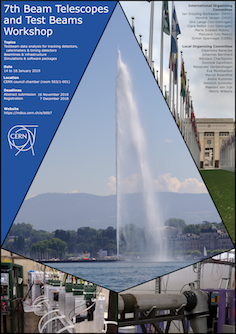Speaker
Description
The upgrades ATLAS and CMS for the High Luminosity LHC (HL-LHC) highlighted physics objects timing as a tool to resolve primary interactions within a bunch crossing. Since the expected pile-up is around 200, with an rms time spread of 170ps, a time resolution of about 30ps is needed. The timing detectors will experience a 1-MeV neutron equivalent fluence of $\Phi_{eq}=10^{14}$ and $10^{15}$cm$^{-2}$ for the barrel and end-cap regions, respectively.
In this contribution, the results of a beam test characterization of deep diffused Avalanche Photo Diodes (APDs) produced by Radiation Monitoring Devices are presented. To improve the detector's timing performance, the APDs are used to directly detect the traversing particles, without a radiator medium where light is produced.
Non-irradiated devices with an active area of $8\times8$mm$^2$ were characterized in beam tests. Two readout schemes were investigated: 1) a direct coupling to the APD with off-sensor capacitive coupling and 2) a capacitive coupling on the sensor realized by means of a metallic mesh isolated from the detector by a kapton layer. The timing performance and signal properties were measured as a function of position on the detector using a beam telescope and an MCP-PMT.




